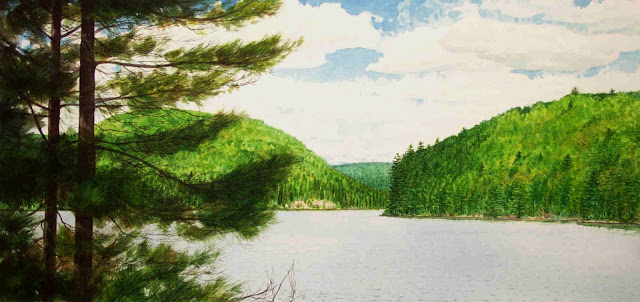You may be wondering about the "PLUS ONE" reference . Well, as I was making these 30 drawings it struck me that perhaps it might be interesting to include a step by step example of how I go about making a drawing. So, I made this extra drawing and as I completed a portion I digitally scanned it. I scanned it several times then set about to make an e-booklet of the Thirty Plus One drawings including the step by step drawing. The 30 drawings, as I've mentioned were sold as a part of a special edition book, and as for Plus One, for the life of me I don't know where it got to. Perhaps, it too was included with the special edition.
As it stands, I have digital scans of the drawings, as well as an e-booklet filed away for posterity. I use the word posterity loosely as with technology changing ever so rapidly no doubt my files will soon become obsolete.
Amazing is it not, just how fast technology has advanced? Some dozen, or so, years ago I purchased a computer with a hard drive 80 megabytes in size. I asked the sales person if I perhaps should purchase some more memory, to which he replied that I'd never have need for more memory. The computer was an early Apple. It became obsolete moments after I purchased it. I've since had several computers with my present computer having a memory capacity of 500 gigabytes enabling files of a size no one thought possible just a couple of years ago. E-books that I published way back in 2002 were 8 megabytes in size possessing very small image files, files that today are totally useless.
This brings me to the question as to whether the files that we're publishing here, within this blog, will survive more than a few moments of computer time. It would be nice to think that some of the thoughts and art of ordinary persons might survive along with those represented by our national institutions. One cannot help but wonder what collective purpose our blogs, this babble, serves?
 |
21. Kakakise Lake II |
 |
22. View Of Killarney & OSA Lakes II |
 |
23. Backside of the Crack |
 |
24. Little Sheguindah Lake |
 |
25. George Island Shoreline |
 |
26. Chikanishing Trail |
 |
27. Island Chikanishing Trail |
 |
28. Norway Lake |
 |
29. Island Carlyle Lake |
 |
30. Beaver Dam - Cranberry Lake |
 |
Plus One - First State |
 |
Plus One - Second State |
 |
Plus One - Third State |
 |
Plus One - Fourth State |
 |
Plus One - Finished Drawing Killarney Landscape |






































